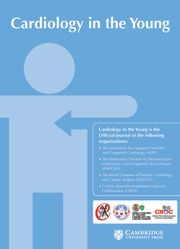No CrossRef data available.
Article contents
Usefulness of percutaneous transluminal coronary balloon angioplasty for coronary artery stenosis after surgery for CHD
Published online by Cambridge University Press: 07 October 2024
Abstract
Coronary artery involvements occur rarely both during cardiac repair and in the late period after surgery, and it may result in myocardial ischaemia and infarction. We present six cases who underwent percutaneous transluminal coronary balloon angioplasty for coronary artery stenosis in the late period after surgery. The patients included four boys and two girls. Post-operative states involving anomalous origin of the left coronary artery from the pulmonary artery and d-transposition of the great arteries were observed in two patients each. Two patients with univentricular heart had coronary artery injuries during surgery. The age at the angioplasty ranged from 1 month to 14 years, with a median of 3 years. The interval from the operation to angioplasty ranged from 37 days to 14 years (median 8 months). The interval from the angioplasty to follow-up coronary angiography ranged from 2 months to 14 years (median 11 months). The follow-up period ranged from 2 months to 20 years (median 8 years). One patient underwent a stent implantation because of post-procedure recoil. Coronary artery stenosis improved immediately after procedure in the six patients without complication, and restenosis occurred post-procedure in one patient. Five patients had no cardiac events. Although the angioplasty’s initial effect may not be dramatic, it can improve late after the procedure. It was considered that the optimal balloon-reference vessel ratio to obtain a minimal effective lumen diameter was about 1.0. Angioplasty post-surgery for CHD in children was feasible and without complications.
Keywords
- Type
- Original Article
- Information
- Copyright
- © The Author(s), 2024. Published by Cambridge University Press



